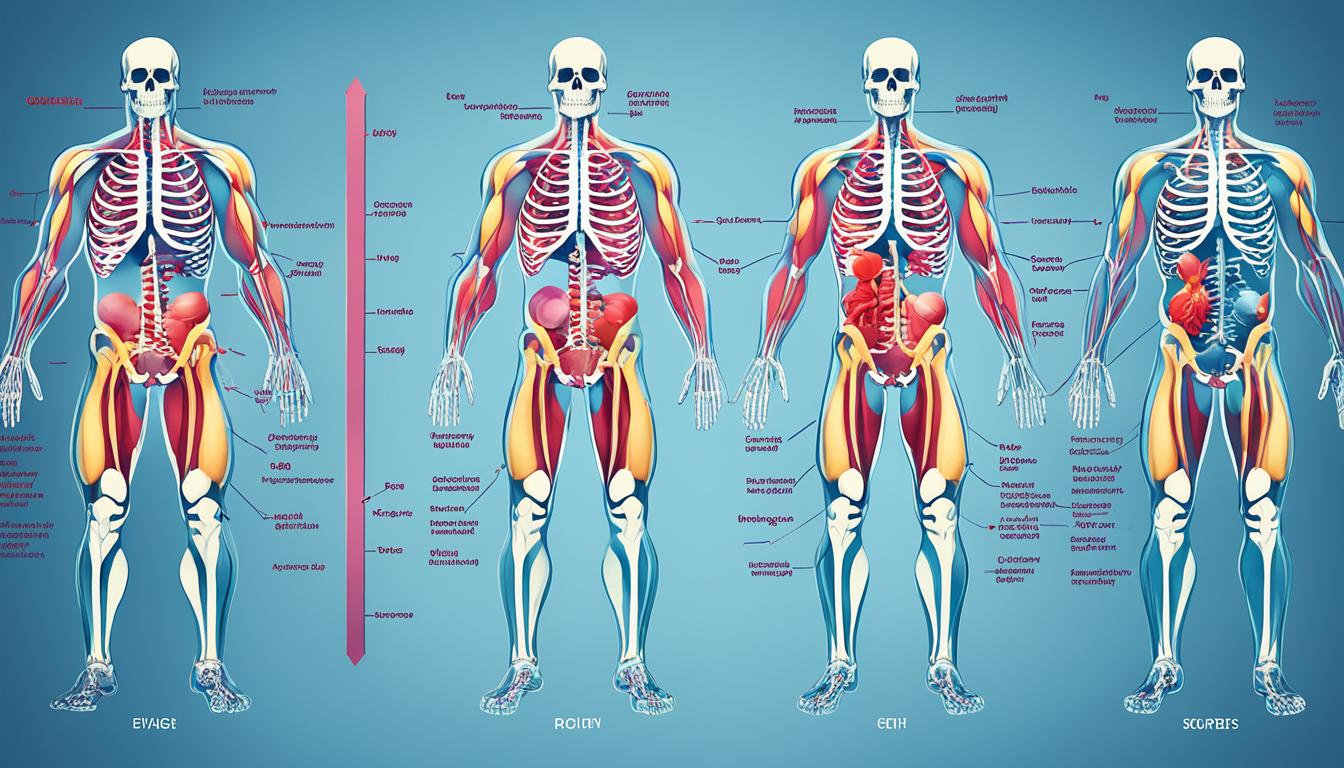Having too much growth hormone can cause hormonal problems. It leads to issues like acromegaly and gigantism. These diseases make the body produce too much growth hormone, affecting how the body grows and works.
Acromegaly is a rare problem that adults often get. It happens when a small non-cancerous growth forms in the pituitary gland. This growth makes the body produce too much growth hormone. People with acromegaly have big hands and feet, and their face and other body parts might look different.
Doctors find acromegaly with tests and special pictures. They check the blood for high levels of growth hormone and another hormone called IGF-I. Then, imaging tests like MRI show if there’s a growth in the pituitary gland.
Treating excess growth hormone usually means lowering those hormone levels. Doctors often do surgery to remove the pituitary gland’s growth. If surgery isn’t an option, medicines or radiation might work.
Doctors are also looking at how stem cell therapy could help with acromegaly. Stem cells might help fix body parts that got damaged because of too much growth hormone.
Key Takeaways:
- Excess growth hormone can lead to disorders such as acromegaly and gigantism.
- Acromegaly is typically caused by a pituitary adenoma and occurs mainly in middle-aged adults.
- Clinical features of acromegaly include broadened extremities, facial deformities, and various health complications.
- Biochemical tests and imaging studies are used to diagnose excess growth hormone disease.
- Treatment options include surgery, medical therapy, and ongoing research into stem cell therapy.
Causes and Mechanisms of Excess Growth Hormone
Excess growth hormone (GH) can happen for many reasons, with pituitary adenoma being the main cause. This benign tumor is in the pituitary gland and leads to most cases of too much GH. However, in rare situations, other tumors or conditions might also cause too much growth hormone.
One condition is ectopic secretion of growth-hormone-releasing hormone (GHRH). This happens when a tumor outside the hypothalamus or pituitary gland produces GHRH. Genetic syndromes like multiple endocrine neoplasia-1 (MEN-1) or McCune-Albright syndrome can also cause more GH production.
Having too much growth hormone can cause acromegaly or gigantism. Acromegaly makes parts of the body grow too much, changing the way someone looks. Gigantism, on the other hand, is when a child grows too big because of too much GH before their bones are done growing.
Researchers are still looking into how these tumors and conditions work to make too much GH. They think that problems in genes, cell signaling, and hormones are all involved.
Comparison of Excess Growth Hormone Conditions
| Condition | Cause | Clinical Features |
|---|---|---|
| Acromegaly | Pituitary adenoma | – Enlargement of extremities |
| – Facial changes | ||
| – Organ enlargement | ||
| Gigantism | Pituitary adenoma (before bone fusion) | – Excessive growth during childhood |
Diagnosis and Treatment of Excess Growth Hormone Disease
Diagnosing excess growth hormone disease, like acromegaly, needs a detailed check. Doctors look for changes in the face and big hands or feet first. These signs help find the problem early.
Tests like the oral glucose tolerance test (OGTT) are key in the diagnosis phase. They check your blood for growth hormone and IGF-I levels. This gives doctors a clear view of the issue.
Doctors also use MRIs to see if a pituitary adenoma is the cause. This type of tumor is usually what makes the body produce too much growth hormone.
The main treatment is often surgery to remove the adenoma. This can fix the problem at its source. But in some cases, surgery isn’t an option. Then, doctors might use medicines or radiation to treat it. Also, scientists are looking into how stem cells might help in the future.
FAQ
Q: What is acromegaly?
A: Acromegaly is a rare disorder where the body makes too much growth hormone (GH). It’s often found in middle-aged adults. A pituitary adenoma, a kind of tumor, causes it usually.
Q: What are the clinical features of acromegaly?
A: People with acromegaly might have bigger hands and feet. They also have changes in their faces and thickened soft tissues. This can cause problems in the heart, lungs, bones, and metabolism.
Q: How is acromegaly diagnosed?
A: Doctors confirm acromegaly with blood tests that check GH and IGF-I levels. They also use MRI to find a tumor on the pituitary gland.
Q: What is the treatment for acromegaly?
A: The main treatment is surgery to remove the tumor. If surgery isn’t an option, doctors may use drugs or radiation. Scientists are looking into stem cell therapy too.
Q: What causes excess growth hormone?
A: A benign tumor in the pituitary gland, called a pituitary adenoma, is usually the cause. But, other issues can overproduce GH. This includes rare conditions or tumors.
Q: What are the symptoms of excess growth hormone?
A: Increase in growth hormone can cause several changes. These include bigger hands and feet, face changes, and organ growth. For kids, it might cause very fast growth.
Q: How is excess growth hormone diagnosed?
A: Doctors combine signs seen in the patient, blood tests, and images to diagnose. Looking at the physical changes can give a clue. A test called OGTT helps confirm it.
Q: What is the primary treatment for excess growth hormone disease?
A: The main way to treat it is by removing the tumor through surgery. If surgery doesn’t work, drugs or radiation might be used. There’s also ongoing study on stem cell therapy as a treatment.

